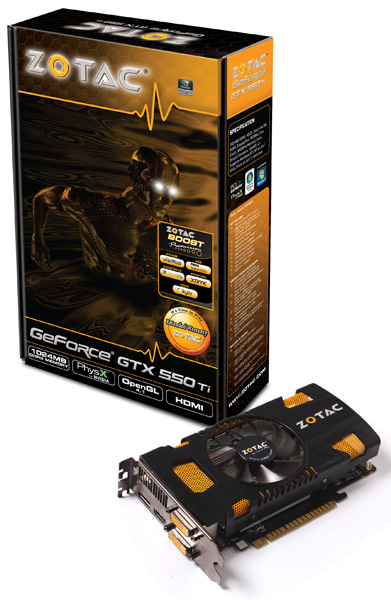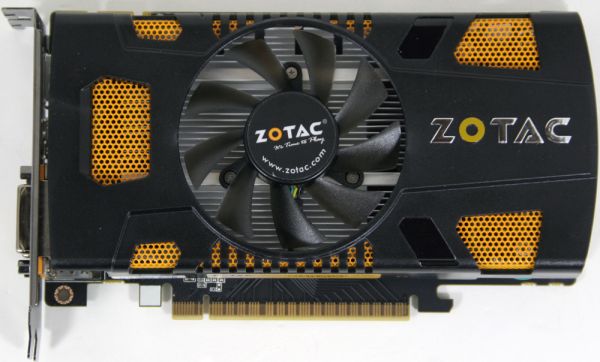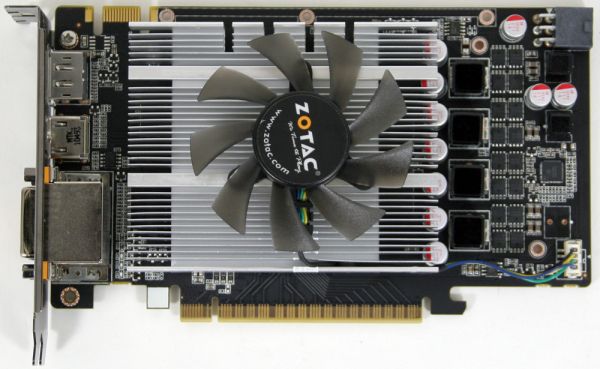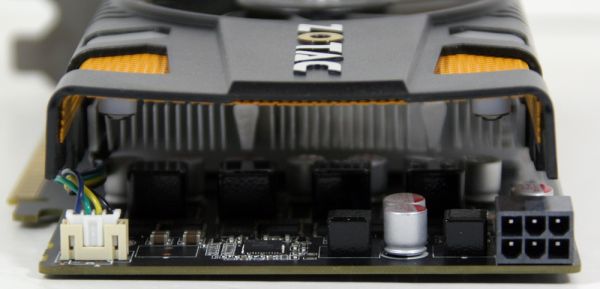NVIDIA's GeForce GTX 550 Ti: Coming Up Short At $150
by Ryan Smith on March 15, 2011 9:00 AM ESTMeet The Zotac GeForce GTX 550 Ti AMP Edition
As we stated at the start of this article, NVIDIA is not directly sampling GTX 550 Ti reference cards for this launch. Instead they have left it up to partners to do the sampling. Zotac in turn has provided us with their factory overclocked model, the GeForce GTX 550 Ti AMP, a custom design clocked at 1000MHz core and 1100MHz (4400MHz data rate) memory. We’ll be looking at performance at both stock GTX 550 and Zotac factory clocks.
The AMP is very similar in design to Zotac’s previous GTS 450 AMP card, which is not surprising given the near-perfect compatibility of the GTS 450 and GTX 550 designs. Zotac does not provide thermal/power data for their cards, but with the factory overclock we’d expect it to be a bit more than the 116W for the reference design.
At a hair under 7.5” and using a double-wide cooler design, the AMP is nearly ¾ of an inch shorter than the original GTS 450, reflecting the fact that NVIDIA’s partners often end up producing shorter cards. A simple shroud covers the card, which directs most of the airflow from the 74mm fan out the front and the rear of the card. If we remove the shroud we find a rectangular aluminum heatsink covering the GPU – the GDDR5 memory remains uncovered.
Power is supplied by a single rear-facing 6pin PCIe power socket, which provides more than enough power for a lower-power device such as the AMP. Zotac has outfitted the chip with Hynix GDDR5; 4 1Gb chips and 2 2Gb chips. All of them are rated for 5GHz operation, so even at 4.4GHz the AMP is running its memory below what the chips are capable of, not counting what the bus and GPU itself are capable of handling. Meanwhile as was the case with the GTS 450, a single SLI connector is provided for 2-way SLI.
A common theme with customized Zotac designs is support for additional display connectivity options beyond the NVIDIA reference design, and Zotac does not disappoint here. By shifting a DVI port to the 2nd slot, Zotac has outfitted the card with a full size DisplayPort, along with upgrading the HDMI port from mini to full size; they are still limited in terms of total displays by the GPU however, and even with 4 ports can only drive 2 displays at once. Zotac continues to be one of the only NVIDIA vendors we regularly see support DisplayPort, a sharp contrast from AMD & their partners who include it on virtually everything.

Rounding out the package is the usual collection of extras from Zotac. For hardware this means a molex-to-PCIe power adapter and a DVI-to-VGA adapter. Meanwhile on the software size Zotac continues to provide the Boost Premium package, which includes a collection of OEM & trial copies of various GPU-accelerated programs, including vReveal, Nero Vision, Cooliris, XBMC, and Kylo.
Zotac is pricing the card at $169 $155, $5 more than the NVIDIA MSRP for a basic card. With it comes a 2 year warranty, and a 3rd year is added upon registration.














79 Comments
View All Comments
Soldier1969 - Wednesday, March 16, 2011 - link
Poor mans card, come back when you get at least a 580 or better...valenti - Thursday, March 17, 2011 - link
Ryan, can you explain where the nodes per day numbers come from?I spend a fair amount of time hanging around folding sites, I can't think of anybody else that uses the nodes per day metric. Most people use PPD (points per day), easily gathered from a F@H statistics program such as HFM.net
I'm unsure how to convert nodes/day to PPD, if that is possible. In actual practice, I find that a 450 card nets almost 10,000PPD, while a 460 gets about 12,000. I prefer the 450, after taking into effect price and power needs.
You might want to search on "capturing a WU" to read about how to copy a protein's work files, allowing you to run the same protein for each card.
suddenone - Thursday, March 17, 2011 - link
How good this card is depends on what monitor you plan on using. Anyone that has a small monitor and plans to keep it for at least three years might be happy with this card. I am puzzled to see fps over 60 on a standard 60hz monitor. My gtx 460 ran fine until I upgraded to a 24 inch 1080p monitor. I sold the card on ebay and bought the gtx 570( big gun). The gtx 570 can run any of my games at over 30fps min with all effects at maximum. Peace out.ol1bit - Thursday, March 17, 2011 - link
I bought 2 460's 6 months ago it so. For 149 each, and they beat the 550 in every catigory.This is a bad launch by Nivida. Old product is faster at same price or lower.
meatfestival - Monday, March 21, 2011 - link
Not sure if it's already been posted, but although it does indeed use id Tech 4, Raven wrote a custom DX9 renderer for it.The multiplayer component (based on the Quake Wars fork of id Tech 4) is on the old OpenGL renderer.
ClagMaster - Friday, March 25, 2011 - link
The GF116 has much optimized and improved performance over that of the GT-450 it is destined to replace.However, the GTX-550 Ti is a low-end replacement for the GT-450 and is priced to much. I wished nVidia called it the GT-550 and reserved the Ti designation for something truly high performance.
For $20 more, I can get a ATI-6850 that gives me 25% more performance for 10% less power consumption.
chrcoluk - Friday, October 21, 2011 - link
I think people are been very harsh on the card.its slower than the older 460 on these benchmarks but the gap isnt a gulf and in addition peopel are completely discounting the power factor. The major problem with graphics cards today is they use too much power, intel have managed to reduce power load whilst increasing performance, yet nvidia cant do the same.
Also no considerations taken on what people are upgrading from, I currently have an 8800GT and am only considering upgrading, a 550 TI would double performance whilst using a little more power on load over the 8800GT and only a 3rd on idle. Buying a 460 would give me a bigger performance boost but I need to connect a 2nd power cable (wtf???) and it uses significantly more power than the 550, about 50% more. so for watts vs performance the 550 beats the 460. But it seems people on here and most other sites consider power consumption as 0 importance, maybe they dont pay their own power bills?
The 550 TI will have many sales because nvidia know most people dont upgrade every year but more likely 3+ years frequency so the 550TI doesnt have to beat the 460 it just has to be significantly better than DX9 and DX8 cards at a good price point whilst also not needing someone to maybe buy a fatter psu as well (not considered here when comparing prices). The 550TI will double my current performance, and I guess the 460 1 gig would be about an extra 20% or so on top of that. Amount of video ram is also important, texture heavy games will saturate 768meg so in those scenarios the 550 is a better choice than the 768 460 model.
xKerberos - Tuesday, January 17, 2012 - link
Oh finally someone who makes some sense! In my country, GTX460s are more expensive than GTX550 Tis and my overclocked Gigabyte 9800gt was struggling to run Battlefield 3 so I picked up an MSI GTX550 Ti with 1gb of ram and factory overclocked. It runs BF3 like a dream at high. And seeing how it munches on VRAM, I'm surprised how people with 768mb cards run that game.Granted I have a tiny 1280x1024 Dell UltraSharp 19" monitor so I don't need a high end card to max games out. My 9800gt was doing a fine job until BF3 came out. I also had to fork out for 8gb of ddr2 ram to run that beast properly.
Anyway what I like about my new card is it was cheap (half the price of GTX560, although at half the performance), it runs very cool (36C on idle in a warm tropical country! max 60C on load), very quiet and it does the job. I won't have to upgrade for a while yet!
UpStateMike - Wednesday, February 22, 2012 - link
I have to agree with this. About a month ago I began the project build to replace an ancient dinosaur that was maxed out and tired.I kept my good 630W ps, a 24" led 1080p viewsonic monitor, and a 9800 gtx card that I figured I could use in the new build.
I started with a new case - rosewill challenger, and build around an i5 Sandy Bridge 2500k put into asus p8z68-vpro mb. I have 8gb of gskill ddr3 1333 at the moment.
Now that this is all up and running, instead of my old system being the performance bottleneck of the video card, the card is now the bottleneck.
I began by trying to cheap out and stay at $80 range, and OC the cards mentioned here, but I liked the lower power use (I'm a medium gamer but I wanted a PC that could handle any game I want to get in the future) of the 550ti and although I'm at $120 for this card, my guess is when I go for my next upgrade phase in about 6 months or so, I can wait for a good deal to come along and get another one to SLI and another 8gb of memory.
So for me, this is a big upgrade that I can build on to SLI and get to where I should be happy for the next couple of years. I do more photography editing and whatnot so this greatly helps me with that and I can still game as I get some time. I can appreciate that the differences are minor for anyone that has bought a card in the last year, but coming from a 9800gtx I'm very happy.